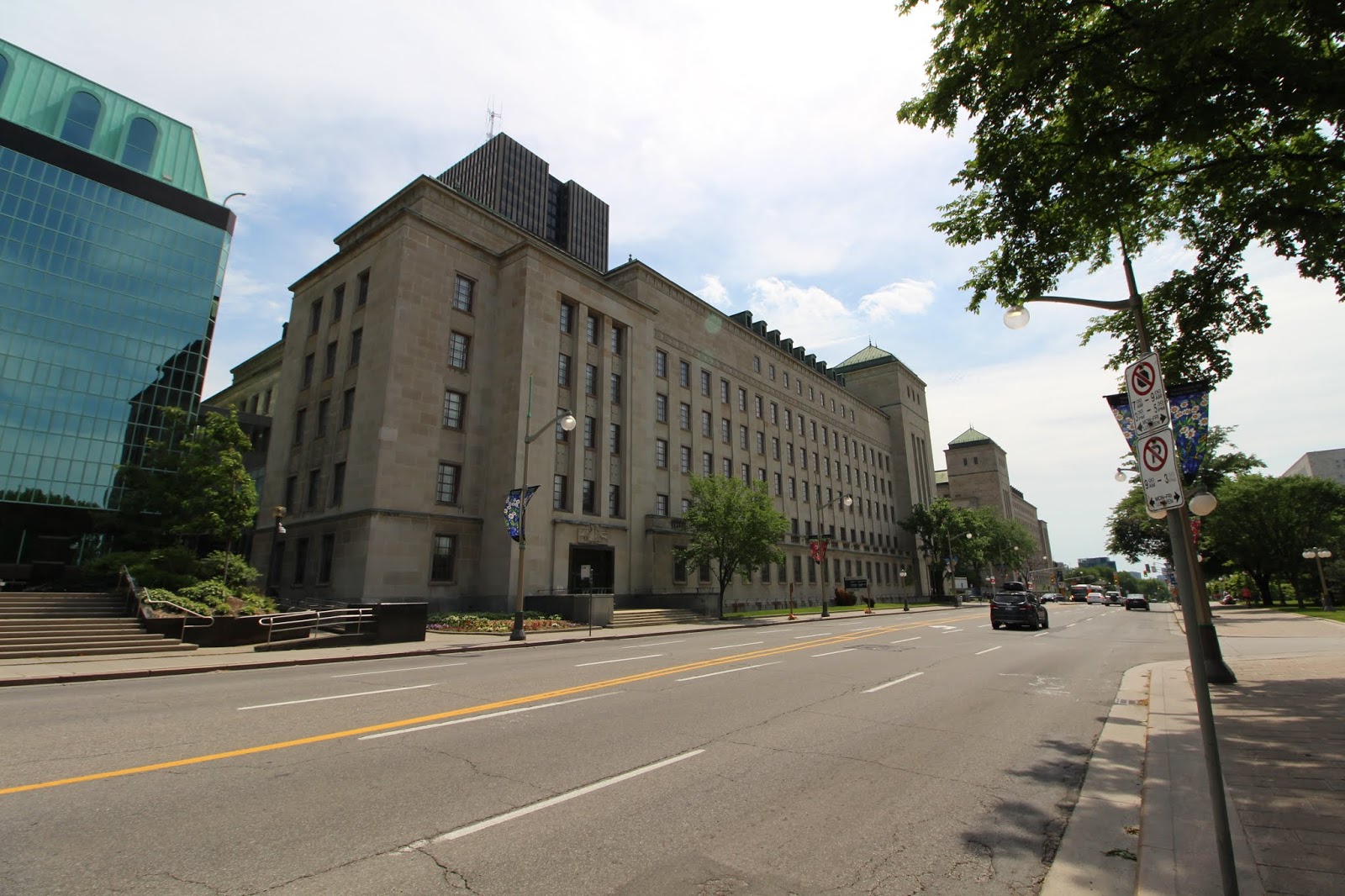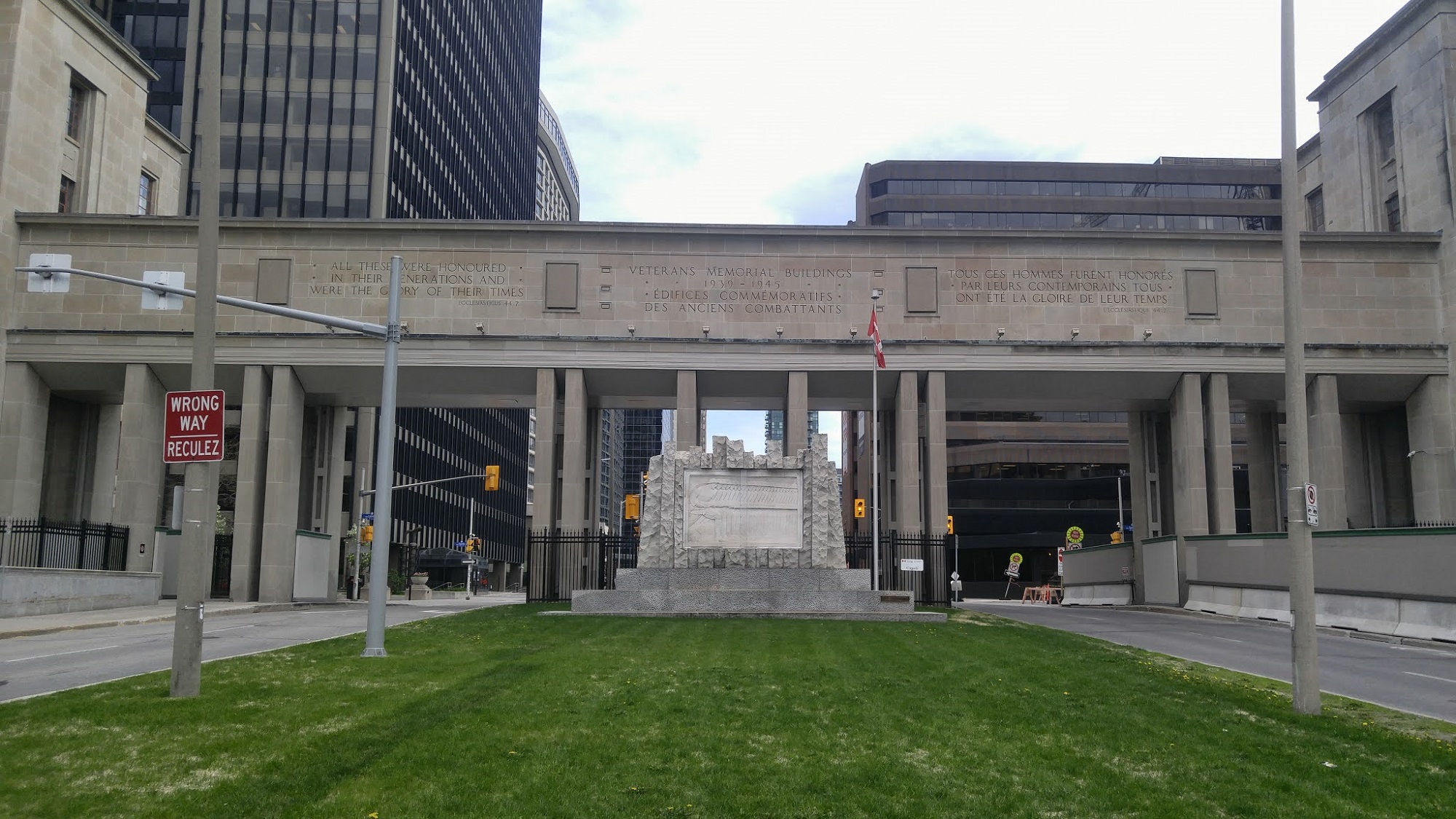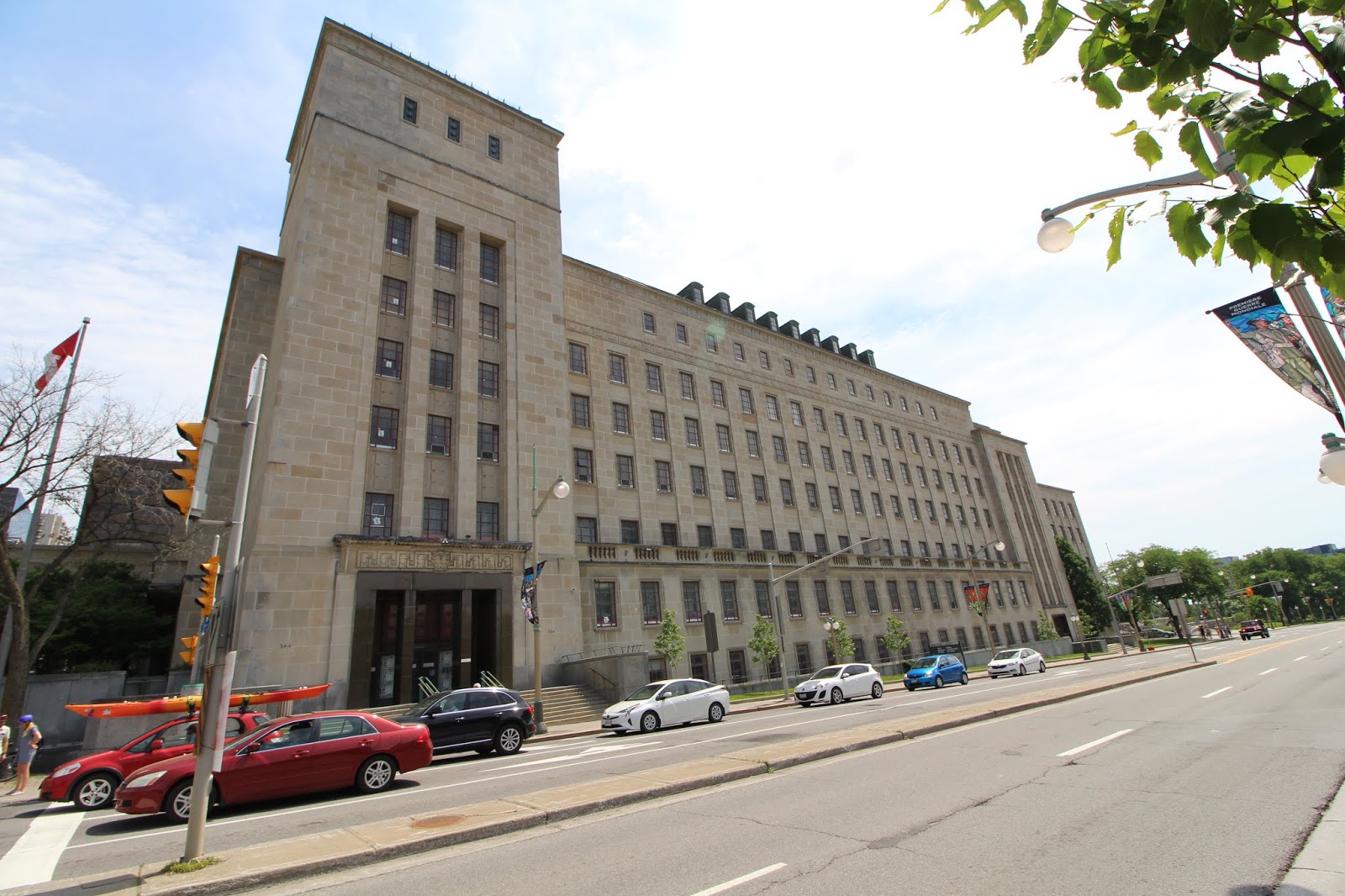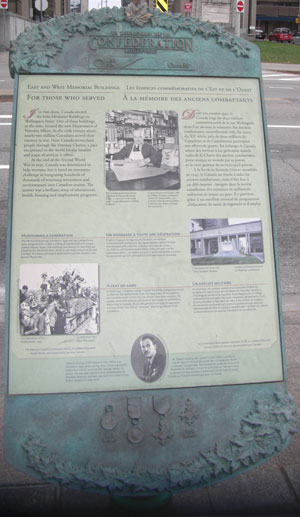Memorial Buildings and Arch
Municipality/Province: Ottawa, ON
Memorial number: 35059-171
Type: Buildings, arch
Address: 284 - 344 Wellington Street
GPS coordinates: Lat: 45.4202541 Long: -75.7056499
These twin buildings are located on Wellington Street in Ottawa. They overlook the Ottawa River and Quebec's Gatineau Hills. Their architecture, in particular their chateau style, copper roofs and stone facing, is in keeping with the Parliament Buildings, the old stone churches and other federal buildings in the vicinity. The architects were Messieurs Allward and Gouinlock. Work on the East Memorial Building began in 1949 and was completed in 1956. The West Memorial Building was completed in 1962.
Construction of the two edifices, originally called "Veterans Memorial Buildings", began following the Second World War. In addition to honouring those who served and those who died in that war, the buildings would also house, under one roof, the employees of the Department of Veterans Affairs and the associated Agencies, who initially were housed in several locations in Ottawa.
The Memorial Arch which connects the East and West Memorial Buildings, as they are now called, spans Lyon Street. Flowerbeds are maintained under the Arch and the area is illuminated at night. A marble relief sculpture, The Canadian Phalanx, stands under the arch.
Inscription found on memorial
[arch/arche]
(front/devant)
ALL THESE WERE HOUNOURED
IN THEIR GENERTAIONS AND
WERE THE GLORY OF THEIR TIMES
ECCLESIASTICUS 44-7
VETERANS MEMORIAL BUILDINGS
1939 – 1945
ÉDIFICES COMMEMORATIFS
DES ANCIENS COMBATANTS
TOUS CES HOMMES FURENT HONORÉS
PAR LEURS CONTEMPORAINS TOUS
ONT ÉTÉ LA GLOIRE DE LEUR TEMPS
L’ÉCCLÉSIASTIQUE 44-7
(back/arrière)
ALL THESE WERE HOUNOURED
IN THEIR GENERTAIONS AND
WERE THE GLORY OF THEIR TIMES
ECCLESIASTICUS 44-7
TOUS CES HOMMES FURENT HONORÉS
PAR LEURS CONTEMPORAINS TOUS
ONT ÉTÉ LA GLOIRE DE LEUR TEMPS
L’ÉCCLÉSIASTIQUE 44-7
[plaque]
For those who served: In the 1950’s, Canada erected the twin Memorial Buildings on Wellington Street. One of those buildings, at the time housed the new Department of Veterans Affairs. In the 20th century alone, nearly two million Canadians served their country in war. Now Canada serves these people through the Veterans Charter, a pact exceptional in the world for the breadth and scope of services it offers.
At the end of the Second World War in 1945, Canada was determined to help veterans, but it faces an enormous challenge in integrating hundreds of thousands of returning servicemen and servicewomen into Canadian society. The answer was a brilliant array of educational, health, housing and employment programs.
Honouring a generation: The memorial Buildings, erected in 1949 and 1955 respectively, were designed with a sleek melding of neoclassical and copper-roofed château styles. The buildings are unusual in that they are linked by the memorial Arch, which is not really an arch at all, but a bridge. The Memorial Arch is dedicated to all who served in the Second World War.
A feat of arms: In April 1945, Canadian troops cross the Rhine and pushed north to liberate the Netherlands from five long years of occupation. As Canadian tanks rolled into one Dutch town after another, the people went wild with joy and took to the streets in celebration. Returning to Canada, those who served from 1939 to 1945 were honoured with the title of “veterans” and the gratitude of all Canadians.
The National Capital Commission (NCC) in collaboration with Public Works and Government Services Canada.
À la mémoire des Anciens Combattants : Dans les années 1950, le Canada érige les deux édifices commémoratifs de la rue Wellington, dont l’un abritera le ministère des Anciens combattants, nouvellement crée. Au cours du XXe siècle, près de deux millions de Canadiens et de Canadiennes participent aux efforts de guerre. En échange. Le Canada assure des services à ces personnes dans le cadre de la Charte des anciens combattants, pacte unique au monde par sa portée et la vaste gamme de services qu’il prévoit.
À la fin de la Seconde Guerre mondiale, en 1945, le Canada est résolu à aider les anciens combattants, mais il fait face à un défi énorme : intégrer dans la société canadienne des centaines de milliers de militaires de retour au pays. Il y parvient grâce à un excellent éventail de programmes d’éducation, de santé, de logement et d’emploi.
Un hommage à toute une génération : Érigés en 1949 et 1955 respectivement, les édifices commémoratifs présentent des lignes épurées alliant le style néoclassique avec celui des châteaux aux toits de cuivre. Les édifices ont la particularité d’être reliés par une « arche commémorative » en réalité un pont. L’arche est dédiée à toutes les personnes qui ont participé à la Seconde Guerre mondiale.
Un exploit militaire : En avril 1945, les troupes canadiennes traversent le Rhin et progressent vers le nord afin de libérer les Pays-Bas, soumis à cinq longues années d’occupation. Dans chaque ville et village néerlandais où arrivaient les tanks canadiens, les habitants, fous de joie, faisaient la fête dans les rues. À leur retour au Canada, les personnes qui avaient pris part à la guerre de 1939 – 1945 ont été honorées su titre d’ « Anciens combattants » et elles ont obtenu la reconnaissance de tous les Canadiens et Canadiennes.
La Commission de la capitale nationale (CCN), en collaboration avec Travaux publics et services gouvernementaux Canada.
Street view
Note
This information is provided by contributors and Veterans Affairs Canada makes it available as a service to the public. Veterans Affairs Canada is not responsible for the accuracy, currency or reliability of the information.
- Date modified:



